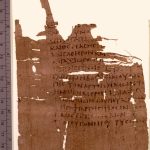| Artefact ID | 1545 |
| TM ID | TM 64491 |
| Findspot (DEChriM ID) | 28 (al-Bahnasā) | Class | Textual |
| Material | Papyrus |
| Writing medium | Sheet/roll |
| Text content | Literary |
| Language | Greek |
| Description | P.Oxy. LX 4010: Introductory prayer and Pater Noster |
| Selection criteria | Literary genre (Biblical), Nomina sacra |
| Date from | 300 |
| Date to | 399 |
| Dating criteria | Palaeography |
| Absolute/relative date | Relative date |
| Archaeological context | Found in al-Bahnasā (Oxyrhynchos) during the excavations of Bernard Grenfell and Arthur S. Hunt between 1896 and 1907. |
| Accession number | Oxford, Sackler Library, Papyrology Rooms P. Oxy. 4010 |


 Json data
Json data




